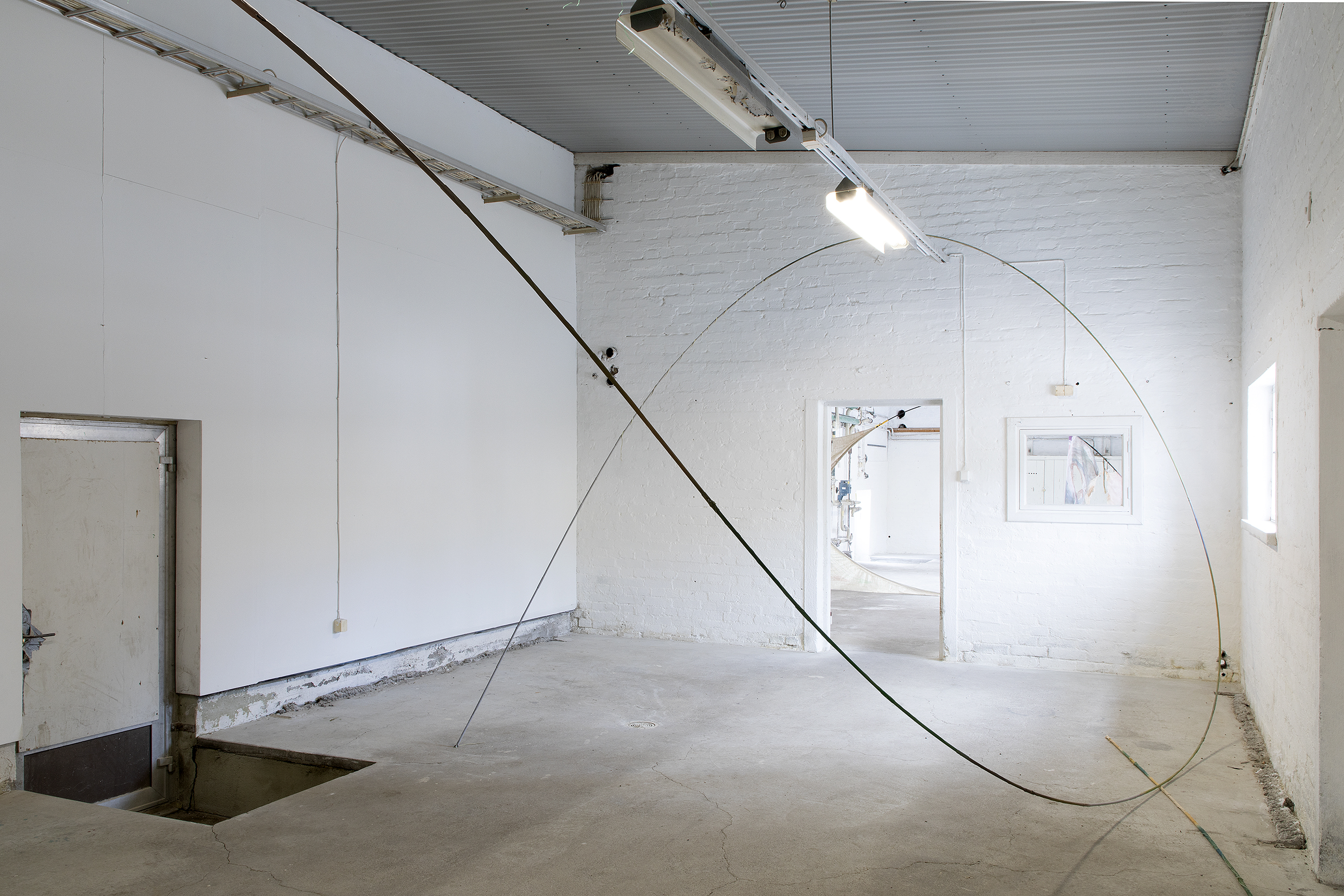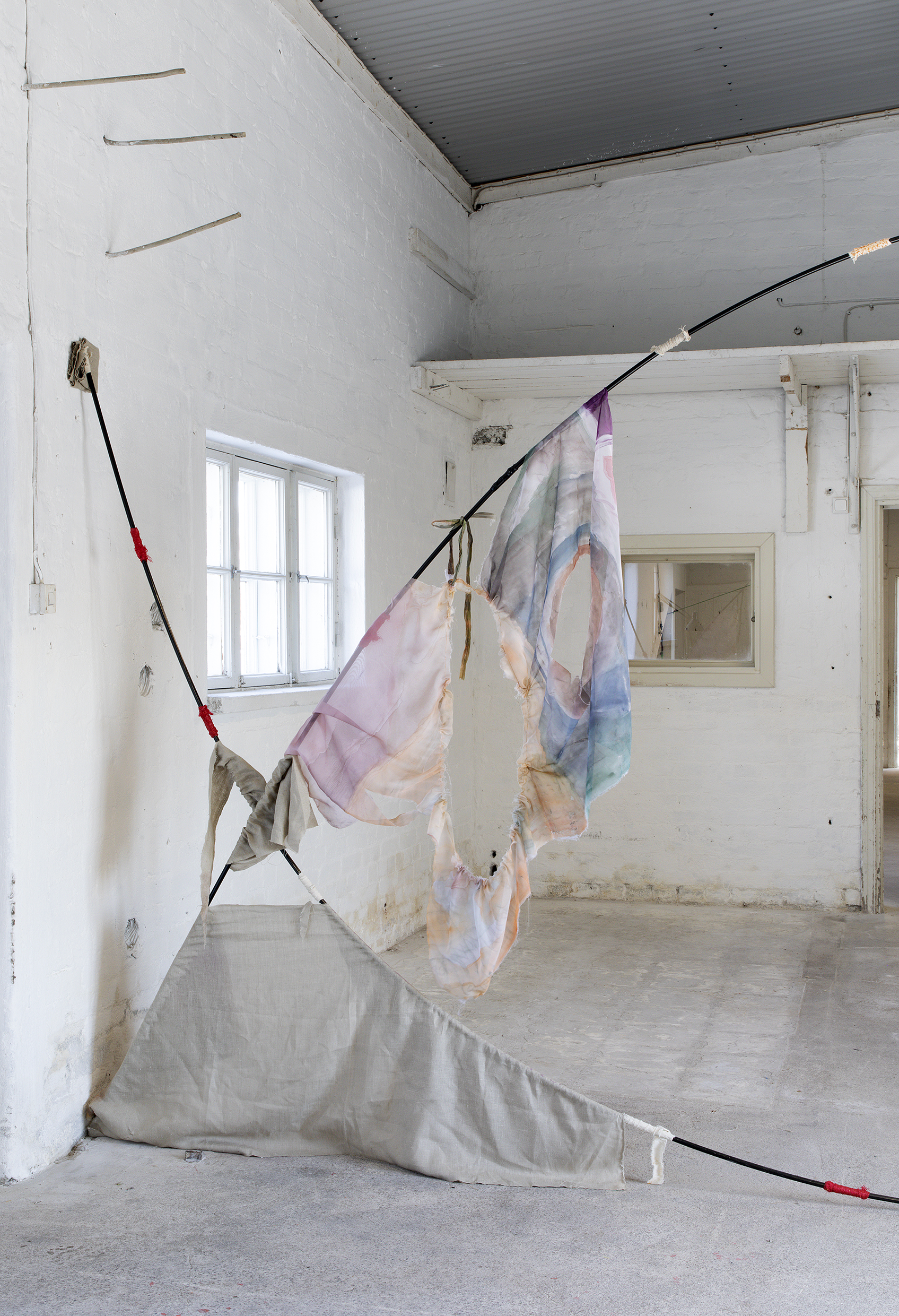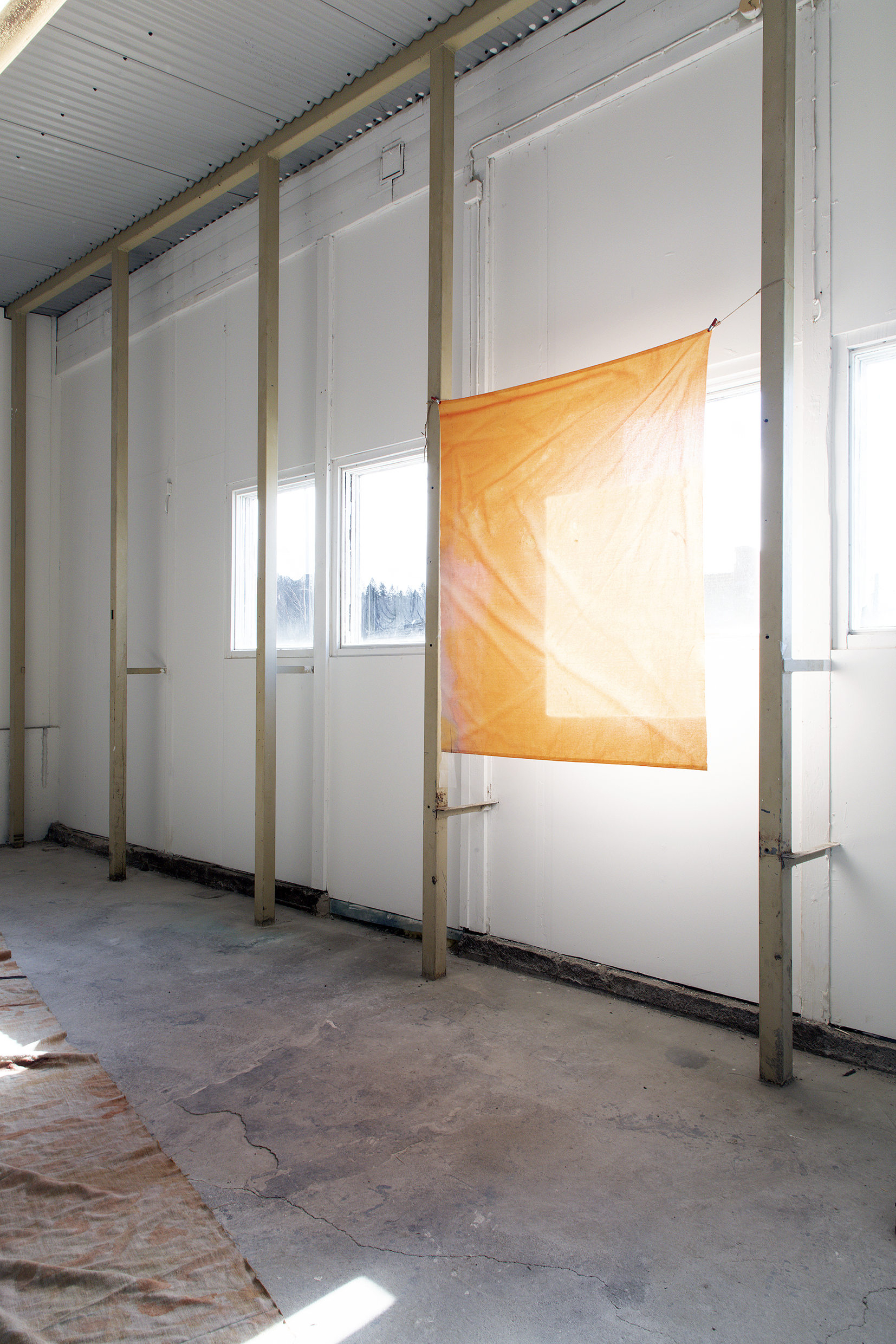







JAANA LAAKKONEN:
ENSIMMÄINEN HUONE TEKEE PAJUILLE
THE FIRST ROOM MAKES FOR WILLOWS
1.–24.4.2022
Näyttely on avoinna / The exhibition is open
ke / wed 12–16
to–pe / thu–fri 16–20
la–su / sat–sun 12–16
Ensiksi ostin kolme kestokassia kuljetusta varten ja lipun neljällä vyöhykkeellä kulkemiseen. Toin mukanani pitkiä kokoontaittuvia kepakoita. Ne koostuvat lyhyistä palasista, joiden avulla kepit taipuvat kaariksi ja niitä voi pidentää.
Käärin itseni joustaviin muoveihin, joita saattoi vähentää tai kerrostaa. Tomua tunkeutui niihin. Toin vettä ja ajoittain vaihdoin sitä kylminpään mitä hanasta sai, mutta lämpimämpään kuin millaiseksi se työskentely- ja näyttelytilassa jäähtyi. Muunsin välipalakeksejä, kikhernekorppuja, marjaista sosetta työn lomassa. Toin muun muassa sipulin väriä edustavia pusseja.
Työhuoneelta otin mukaani kaksi maalista kangasta, jotka olivat olleet siellä vuodesta 2019. Parin ensimmäisen päivän jälkeen aloin kuljettaa mukanani aurinkovoidetta, jota lisäsin ennen kuin istahdin tauolle pajujen tilaan. Kenkäni rouhaisi sammalta rapuilta ja näin värjäsi lunta, joka hupeni. Toin myös jauhoisia ja rasvaisia värejä.
Toin klipsejä, pienen laatikollisen kiinalaisia lasinpaloja, rihmaa, neulan, mattoveitsen, lehtiön, johon kirjoitin vain osia tästä tekstistä, ja kynän, joka ei ollut joka päivä mukana. Toin säkin ja sen päälle vanhan takin, jotten viilenisi ja tulehtuisi rappusella. Paikalla oli pakahduttavan paljon ennen tuomisiani.
Alkuperäisenä tavoitteenani oli kulkea, kokeilla, työskennellä työni kysymysten kanssa Nikkilän lomassa. Ensimmäisinä päivinä kahlasin psykiatrisen sairaalan hautausmaan halki sekä liukastelin pieniä teitä ympäriinsä. Kiikarisymboli johti vain mastolle, tikapuut siirtolohkareelle, tie yksityisen tilan pihaan ja luonto-kulttuuri kietoutumia surisi kaikkialla, tietenkin.
Kirjoitin ensimmäisistä päivistä lyhyitä muistiinpanoja puhelimeen. Kirjoitin ylös kartoista, ikkunoista irroitetuista vanereista, tiistaina 20-kiloiseen kohdistuneesta väkivallasta, lasien välissä heränneestä kärpäsestä, suurista hiiltyneistä puista, lumen alta paljastuneesta myrkyttömästä syötistä. Jäin pahaan pajukoukkuun ja hain niistä tietoa minkä ehdin. Olisin halunnut taivutellakin ja en.
Niin paljon tapahtui ihan 'vain' entisissä kasvihuoneissa, osassakin niistä, että kuljeksimiseni säde kaventui. Minua kiinnostaa tämä tungoksinen kanssa-työskentely, jossa aika, paikka, historia, lämpötila, ekologiat, ekonomiat.. .. .. … ovat toisissaan. Teokset osuvat niihin, kiertyvät muotoihinsa vain niissä juuri niin.
Työskentelin K17 taiteen ja ekologian koetilassa, Nikkilässä, Sipoossa maaliskuun 2022. Tämän työskentelyn tuottamia teoksia ja näyttely on esillä 1.–24.04.2022. Olen paikalla näyttelyssä lauantaina 2.4. klo 12–16. Lämpimästi tervetuloa!
Työskentelyä on tukenut Suomen Kulttuurirahasto.
Biografia:
Jaana Laakkonen on syntynyt Joensuussa vuonna 1985 ja hän asuu sekä työskentelee Helsingissä. Jaana on viime vuosien työskentelyssään pohtinut ja testannut mitä tarkoittaa työskennellä maalin ja kirjoittamisen kanssa feministisen posthumanismin ja -tieteenflosofan valossa. Hänen kokeellisessa työskentelyssään materiaalit, tekstit ja arkielämän tilanteet nivoutuvat yhteen sekä muotoutuvat näyttelytiloissa ja -tilanteissa.
Jaanalla on postgraduate maisterin tutkinto Master of Research in Art and Design -ohjelmasta st Lucas School of Arts Antwerpenistä Belgiasta (2017) ja hän on valmistunut kuvataiteen maisteriksi Taideyliopiston Kuvataideakatemiasta (2014). Hänen viimeisimmät yksityisnäyttelyt ovat ouoùouille Treignac Projet:ssa, Ranskassa (2020), Kuivia pisaroita lattiassa ja MAA-tilassa sekä ~=2cm, syvä=~ Oksasenkatu11:ssä (2021), Helsingissä. Vuonna 2021 berliiniläinen kustantamo Archive Books julkaisi hänen esseistä koostuvan kirjan They Inhabit While Working. Jaanan teoksia on seuraavaksi esillä Yhdysvaltalaisessa Cincinnati CAC -nykytaidekeskuksessa Amara Antillan ja Clelia Coussonnet:n kuratoimassa näyttelyssä Breaking Water.
Käärin itseni joustaviin muoveihin, joita saattoi vähentää tai kerrostaa. Tomua tunkeutui niihin. Toin vettä ja ajoittain vaihdoin sitä kylminpään mitä hanasta sai, mutta lämpimämpään kuin millaiseksi se työskentely- ja näyttelytilassa jäähtyi. Muunsin välipalakeksejä, kikhernekorppuja, marjaista sosetta työn lomassa. Toin muun muassa sipulin väriä edustavia pusseja.
Työhuoneelta otin mukaani kaksi maalista kangasta, jotka olivat olleet siellä vuodesta 2019. Parin ensimmäisen päivän jälkeen aloin kuljettaa mukanani aurinkovoidetta, jota lisäsin ennen kuin istahdin tauolle pajujen tilaan. Kenkäni rouhaisi sammalta rapuilta ja näin värjäsi lunta, joka hupeni. Toin myös jauhoisia ja rasvaisia värejä.
Toin klipsejä, pienen laatikollisen kiinalaisia lasinpaloja, rihmaa, neulan, mattoveitsen, lehtiön, johon kirjoitin vain osia tästä tekstistä, ja kynän, joka ei ollut joka päivä mukana. Toin säkin ja sen päälle vanhan takin, jotten viilenisi ja tulehtuisi rappusella. Paikalla oli pakahduttavan paljon ennen tuomisiani.
Alkuperäisenä tavoitteenani oli kulkea, kokeilla, työskennellä työni kysymysten kanssa Nikkilän lomassa. Ensimmäisinä päivinä kahlasin psykiatrisen sairaalan hautausmaan halki sekä liukastelin pieniä teitä ympäriinsä. Kiikarisymboli johti vain mastolle, tikapuut siirtolohkareelle, tie yksityisen tilan pihaan ja luonto-kulttuuri kietoutumia surisi kaikkialla, tietenkin.
Kirjoitin ensimmäisistä päivistä lyhyitä muistiinpanoja puhelimeen. Kirjoitin ylös kartoista, ikkunoista irroitetuista vanereista, tiistaina 20-kiloiseen kohdistuneesta väkivallasta, lasien välissä heränneestä kärpäsestä, suurista hiiltyneistä puista, lumen alta paljastuneesta myrkyttömästä syötistä. Jäin pahaan pajukoukkuun ja hain niistä tietoa minkä ehdin. Olisin halunnut taivutellakin ja en.
Niin paljon tapahtui ihan 'vain' entisissä kasvihuoneissa, osassakin niistä, että kuljeksimiseni säde kaventui. Minua kiinnostaa tämä tungoksinen kanssa-työskentely, jossa aika, paikka, historia, lämpötila, ekologiat, ekonomiat.. .. .. … ovat toisissaan. Teokset osuvat niihin, kiertyvät muotoihinsa vain niissä juuri niin.
Työskentelin K17 taiteen ja ekologian koetilassa, Nikkilässä, Sipoossa maaliskuun 2022. Tämän työskentelyn tuottamia teoksia ja näyttely on esillä 1.–24.04.2022. Olen paikalla näyttelyssä lauantaina 2.4. klo 12–16. Lämpimästi tervetuloa!
Työskentelyä on tukenut Suomen Kulttuurirahasto.
Biografia:
Jaana Laakkonen on syntynyt Joensuussa vuonna 1985 ja hän asuu sekä työskentelee Helsingissä. Jaana on viime vuosien työskentelyssään pohtinut ja testannut mitä tarkoittaa työskennellä maalin ja kirjoittamisen kanssa feministisen posthumanismin ja -tieteenflosofan valossa. Hänen kokeellisessa työskentelyssään materiaalit, tekstit ja arkielämän tilanteet nivoutuvat yhteen sekä muotoutuvat näyttelytiloissa ja -tilanteissa.
Jaanalla on postgraduate maisterin tutkinto Master of Research in Art and Design -ohjelmasta st Lucas School of Arts Antwerpenistä Belgiasta (2017) ja hän on valmistunut kuvataiteen maisteriksi Taideyliopiston Kuvataideakatemiasta (2014). Hänen viimeisimmät yksityisnäyttelyt ovat ouoùouille Treignac Projet:ssa, Ranskassa (2020), Kuivia pisaroita lattiassa ja MAA-tilassa sekä ~=2cm, syvä=~ Oksasenkatu11:ssä (2021), Helsingissä. Vuonna 2021 berliiniläinen kustantamo Archive Books julkaisi hänen esseistä koostuvan kirjan They Inhabit While Working. Jaanan teoksia on seuraavaksi esillä Yhdysvaltalaisessa Cincinnati CAC -nykytaidekeskuksessa Amara Antillan ja Clelia Coussonnet:n kuratoimassa näyttelyssä Breaking Water.
First, I bought three polypropylene bags for transport and a ticket to travel in four zones. I bought and brought 6-7 metres long collapsible sticks with me. They consist of shorter pieces that allow the rods to bend into curves and be extended. I wrapped myself in flexible plastics that could be de/layered. Dust filtered into them.
I brought water and occasionally replenished it to the coldest that I got from the faucet yet warmer than it became in the working and exhibition space. I converted oat snacks, chickpea crackers, berry puree while I worked. I brought meshbags that represented the colour of an onion, among other things. From my studio, I took two painted fabrics that had been there since 2019.
After the first couple of days, I started carrying a bottle of sunscreen with me. I used it before I sat down for a break in the space of willows. My shoes scattered the moss from the stairs and coloured the snow which dwindled. I also brought powdery and greasy colours.
I brought spring clamps, a small box of Chinese glass shards, sewing thread, a needle, a carpet knife, a notebook on which I wrote parts of this text only, and a pen that stayed home for some of the days. I brought a plastic sack and an old jacket over it, to prevent me from cooling down too much and getting inflamed on the stairs. There was so much, and so much going on before I brought anything.
My initial goal was to walk, move, test, and work-with the questions of my artistic practice in Nikkilä during my one-month working period. In the first days, I waded through the cemetery of the psychiatric hospital and slipped around small roads. The binocular symbol led only to a telephone mast, or similar, the ladder on a glacial erratic, the road to a private farm yard. Everything was teeming with natural-cultural entanglements, of course.
I wrote brief notes on my phone about the first few days. I jotted about the maps, the plywood removed from the windows, the violence against a 20kg person on Tuesday, a fly waking up between glasses, large charred trees, the non-toxic bait exposed under the snow. I got hooked on the willows and hunted for information about them. I would have also liked to bend the willows, and not.
So much was happening in the former greenhouses, even in only some parts of them, that the radius of my walks contracted. I am curiously interested in this crowded practice of working-with – where time, place, history, temperature, ecologies, economics .. .. ..… are intertwined. The (art)works touch them, and are figured with/in them.
I worked in K17 Space for Art and Ecology in Nikkilä (Sipoo, Finland) in March 2022. The works produced during this period will be exhibited 1.–24.4.2022. I will be present at the exhibition on Saturday 2nd of April between 12–16. Warmly welcome!
The Finnish Cultural Foundation supported the practice that led to this exhibition.
Biography:
Jaana Laakkonen (b.1985 in Joensuu, Finland) is an artist currently living and working in Helsinki, Finland. In recent years her artistic practice has reflected and tested what it means to work with paint and writing in light (or mud!) of feminist posthumanist critical thinking and feminist philosophy of science. Jaana's artistic practice is a continuous experimental process of studio work and writing where different materials, texts and everyday situations are intertwined. After all, her artworks – with the associated texts – are shaped by the terms of the exhibition spaces and exhibiting situations.
Jaana holds a postgraduate master's degree of Master of Research in Art and Design programme of st Lucas School of Arts Antwerp, BE (2017) and a MFA from University of Arts Helsinki's Academy of Fine arts, FI (2014). Her most recent solo exhibitions are ~=2cm, deep=~ in Oksasenkatu11 and Dry Drops in the Floor and in MAA-tila Project Space, both in Helsinki, FI (2021) and ouoùouille in Treignac Projet, Treignac, FR (2020). In 2021 her written work was published in the form of a book called They Inhabit While Working by Archive Books, Berlin, Germany. Jaana's works can be encountered next in a group exhibition Breaking Water in Cincinnati Contemporary Arts Center (US) curated by Amara Antilla and Clelia Coussonnet.